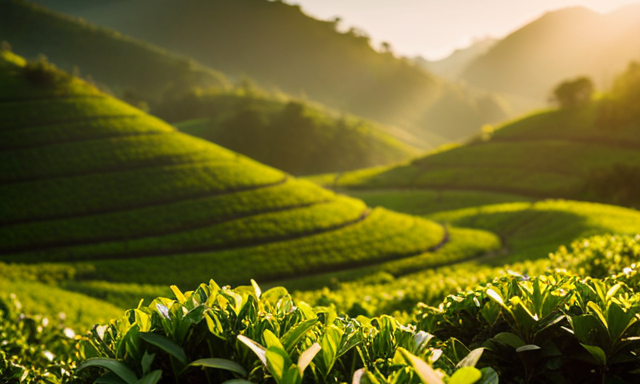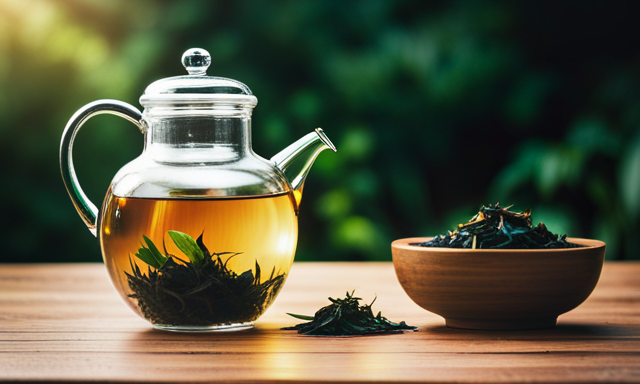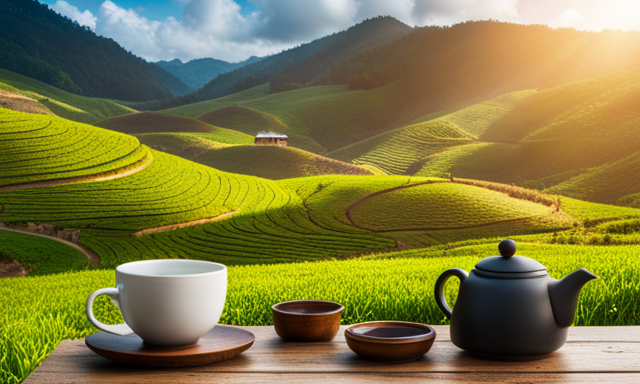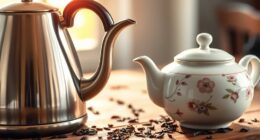Ever pondered the reason behind oolong tea being named as such?
Well, let me unravel the mystery for you. Oolong tea, with its unique name, has a fascinating story behind it. It all starts with its origins in China, where this exquisite tea has been cherished for centuries.
The term ‘oolong’ is actually a euphemism, derived from the Chinese word ‘wu long,’ which translates to ‘black dragon.’ This name perfectly captures the essence of oolong tea – a drink that embodies strength and power, just like a mighty dragon.
But oolong tea is not just about its name; it’s also about its tantalizing taste profile and the meticulous process of cultivation and harvesting. Join me as we delve into the history, cultivation, processing techniques, health benefits, and cultural significance of oolong tea.
Get ready to explore the world of oolong tea and discover why it holds a special place in Chinese culture and beyond.
Key Takeaways
- Oolong tea is named after the Chinese word ‘wu long,’ meaning ‘black dragon’.
- The name ‘oolong’ captures the strength and power associated with a dragon.
- The name ‘oolong’ refers to the dark, twisted appearance of the tea leaves.
- Oolong tea has a rich history dating back centuries in China.
History and Origins of Oolong Tea
Let’s dive into the fascinating history and origins of oolong tea and discover why it earned its distinctive name. Oolong tea has a rich history that dates back centuries, originating in the Fujian province of China during the Ming Dynasty.
The production of oolong tea is a meticulous process that requires skilled tea masters. The leaves are carefully plucked, withered under the sun, and then partially oxidized before being curled or twisted. This unique combination of oxidation levels gives oolong tea its characteristic flavor and aroma.
The name ‘oolong’ itself has an interesting meaning. In Chinese, ‘oo’ means black, and ‘long’ means dragon. This is said to be a reference to the dark, twisted appearance of the tea leaves, which resemble the shape of a dragon.
Let’s now explore the meaning and translation of ‘oolong’ in the subsequent section.
The Meaning and Translation of ‘Oolong’
Originating from China, the name ‘oolong’ dances across the tongue like a delicate breeze through a field of fragrant flowers. The word ‘oolong’ is derived from the Chinese term ‘wu long’, which translates to ‘black dragon’. This name holds deep cultural significance and symbolism.
It is believed that oolong tea was named after its appearance, which resembles a black dragon unfurling its long, winding body. The term ‘black dragon’ also represents power, strength, and good fortune in Chinese culture. When sipping a cup of oolong tea, one can’t help but be transported to the mystical realm of ancient China, where legends of dragons and prosperity abound.
The name ‘oolong’ encapsulates the rich history, cultural heritage, and symbolic imagery associated with this beloved tea.
Now, let’s delve into the unique taste profile of oolong tea.
The Unique Taste Profile of Oolong Tea
Savor the exquisite flavor of oolong, a brew that tantalizes the taste buds with its delicate balance of floral and earthy notes. Oolong tea has a truly unique flavor profile that sets it apart from other teas. Its taste can range from light and fruity to rich and roasted, depending on the specific variety and how it’s brewed. The leaves of oolong tea are only partially fermented, which gives it a distinct flavor that is neither fully green nor black tea. The brewing methods for oolong tea also contribute to its exceptional taste. Whether you choose to steep it in a gaiwan or a traditional teapot, the brewing process enhances the intricate flavors of oolong, resulting in a truly satisfying cup of tea. As we dive into the cultivation and harvesting of oolong tea, we’ll discover the fascinating journey from plant to cup.
The Cultivation and Harvesting of Oolong Tea
The cultivation and harvesting of oolong tea involve careful attention to every step, ensuring the highest quality leaves are selected for a truly exceptional brew.
Cultivation techniques for oolong tea vary depending on the specific type and desired flavor profile. Some farmers prefer to grow the tea plants in shaded areas to enhance the leaves’ sweetness, while others opt for direct sunlight to bring out a more robust flavor.
Tea harvesting methods also play a crucial role in oolong tea production. The leaves are typically hand-picked, allowing skilled workers to select only the tenderest and most flavorful leaves. This labor-intensive process ensures that each cup of oolong tea delivers a rich and complex taste.
Moving on to oolong tea processing techniques, the leaves undergo a series of meticulous steps to unlock their unique flavors and aromas.
Oolong Tea Processing Techniques
One fascinating aspect of oolong tea processing is that it takes approximately 12 hours to complete, from withering to the final drying stage. The processing techniques used for oolong tea play a crucial role in creating its distinct flavor profiles.
After withering, the leaves are carefully shaken or tossed to initiate oxidation. This step is followed by the crucial skill of heat application, where the leaves are pan-fried, rolled, or roasted to stop the oxidation process. The level of oxidation and the degree of heat applied determine the flavor and aroma of the tea.
Oolong teas can vary from light and floral to bold and roasted, offering a wide range of flavor experiences. These processing techniques contribute to the unique taste and character of oolong teas, making them highly sought after by tea enthusiasts.
Moving on to famous oolong tea varieties and regions…
Famous Oolong Tea Varieties and Regions
Explore the enticing world of famous oolong tea varieties and regions, where you can embark on a flavorful journey filled with delightful surprises and aromatic wonders. Oolong tea is known for its diverse range of flavors and aromas, making it a favorite among tea enthusiasts. Some of the famous oolong tea varieties include Tie Guan Yin, Da Hong Pao, and Oriental Beauty. Each variety has its own unique characteristics, ranging from floral and fruity to toasty and nutty. These teas are cultivated in different regions, such as Fujian and Taiwan, where the climate and soil conditions contribute to their distinct flavors. The table below showcases some of the famous oolong tea varieties and the regions they are grown in.
| Variety | Region |
|---|---|
| Tie Guan Yin | Fujian |
| Da Hong Pao | Wuyi Mountains |
| Oriental Beauty | Taiwan |
As you can see, oolong tea is deeply rooted in tradition and craftsmanship, making it a fascinating beverage to explore. Now, let’s delve into the health benefits of oolong tea.
Health Benefits of Oolong Tea
Oolong tea offers a myriad of health benefits due to its antioxidant properties. These antioxidants help to neutralize harmful free radicals in the body, reducing the risk of chronic diseases and promoting overall health.
Additionally, oolong tea has been shown to support weight management efforts by boosting metabolism and aiding in fat oxidation.
Lastly, regular consumption of oolong tea has been linked to improved heart health, as it can help lower cholesterol levels and reduce the risk of heart disease.
Antioxidant Properties
Indulge yourself in the antioxidant-rich goodness of oolong tea, and watch as your body is flooded with a wave of health benefits. Oolong tea has been extensively studied for its antioxidant properties, particularly in relation to cancer prevention. Here are four key findings from antioxidant research on oolong tea:
-
Oolong tea contains polyphenols, powerful antioxidants that help neutralize harmful free radicals in the body.
-
The polyphenols in oolong tea have been shown to inhibit the growth of cancer cells and reduce the risk of certain types of cancer.
-
Oolong tea also contains catechins, which have been found to have anti-inflammatory and anti-tumor properties.
-
Regular consumption of oolong tea may help strengthen the immune system and protect against oxidative stress.
Transitioning into the next section about weight management support, oolong tea can also be a valuable ally in achieving your weight loss goals.
Weight Management Support
Take advantage of the weight management support provided by oolong tea and watch as it becomes your valuable ally in achieving your weight loss goals. Oolong tea has been found to aid in weight loss by boosting metabolism. The polyphenols present in oolong tea activate certain enzymes that enhance the function of fat cells and help the body burn stored fat more efficiently. This metabolic boost can lead to increased calorie burning and ultimately contribute to weight loss.
Additionally, oolong tea can help regulate blood sugar levels, which can help control cravings and prevent overeating. With its natural properties, oolong tea can be a beneficial addition to a healthy weight loss plan.
Now, let’s delve into the next section to explore the heart health benefits of oolong tea.
Heart Health Benefits
By incorporating oolong tea into your routine, you can discover the numerous benefits it offers for heart health. Oolong tea has been found to aid in heart disease prevention by reducing the risk factors associated with it.
One of the key benefits is its ability to reduce cholesterol levels in the body. High levels of cholesterol can lead to the buildup of plaque in the arteries, increasing the risk of heart disease. Drinking oolong tea regularly can help lower LDL cholesterol, also known as the ‘bad’ cholesterol, while increasing HDL cholesterol, the ‘good’ cholesterol. This helps maintain a healthy balance and prevent the accumulation of plaque.
Additionally, oolong tea contains antioxidants that protect the heart from oxidative stress and inflammation.
Transitioning into the subsequent section about brewing and serving oolong tea, it’s important to understand the proper techniques to fully enjoy its heart-healthy benefits.
Brewing and Serving Oolong Tea
To truly appreciate the delicate flavors and aroma of oolong tea, steep it at the recommended temperature and allow it to unfurl its leaves, revealing a complex and nuanced brew that’ll transport you to a place of tranquility and contemplation.
Oolong tea requires proper brewing techniques to bring out its best qualities. Start by using water that’s around 180-200°F (82-93°C) and steep the leaves for 2-3 minutes. The exact steeping time may vary depending on personal preference and the specific oolong tea variety. For a stronger flavor, you can steep it for a little longer.
Once brewed, oolong tea can be enjoyed plain or with a touch of honey or lemon. Its versatility makes it a delightful choice for both hot and iced tea.
As we delve into the rich history of oolong tea in traditional Chinese culture, you’ll discover the fascinating stories and customs that’ve shaped its enduring popularity.
Oolong Tea in Traditional Chinese Culture
Now that we have explored the process of brewing and serving Oolong tea, let’s delve into its significance in traditional Chinese culture. Oolong tea holds a prominent place in Chinese tea ceremonies, which are steeped in symbolism and tradition. These ceremonies are often seen as a way to honor the art of tea making and to bring people together in a shared appreciation for this beloved beverage. Oolong tea is believed to represent harmony, balance, and tranquility, making it a perfect choice for these ceremonial gatherings. In fact, the preparation and serving of oolong tea in traditional Chinese culture is considered an art form in itself. As we continue our exploration, we will now turn our attention to the fascinating world of oolong tea variations and pairings.
Exploring Oolong Tea Variations and Pairings
Let’s dive into the fascinating world of different flavors and combinations that oolong tea offers. Oolong tea is known for its diverse range of flavors, from floral and fruity to toasty and nutty.
Each variation of oolong tea brings a unique taste profile that can be enjoyed on its own or paired with various desserts. Here are four delightful combinations to explore:
-
A light and floral oolong tea pairs perfectly with a delicate green tea cake, creating a harmonious balance of flavors.
-
For a rich and creamy experience, try a roasted oolong tea with a velvety chocolate mousse. The smoky undertones of the tea complement the decadent sweetness of the dessert.
-
A fruity oolong tea, such as peach or plum, enhances the flavors of a tangy lemon tart, creating a refreshing and vibrant combination.
-
If you prefer a nutty oolong tea, like almond or walnut, pair it with a buttery pecan pie for a delightful contrast of textures and flavors.
With oolong tea, the possibilities for flavor exploration and dessert pairings are truly endless.
Frequently Asked Questions
How long does it take to process oolong tea?
The processing time for oolong tea can vary depending on the desired oxidation levels. Generally, it takes around 1-2 hours for light oxidation, 2-4 hours for medium oxidation, and 4-8 hours for heavy oxidation.
Are there any specific health risks associated with drinking oolong tea?
Drinking oolong tea can offer specific health benefits, like aiding in weight management and improving heart health. However, it’s important to be aware of potential side effects, such as caffeine sensitivity and digestive issues.
What is the ideal temperature for brewing oolong tea?
The ideal temperature for brewing oolong tea is around 180 to 200 degrees Fahrenheit. To achieve the best steeping techniques, use a tea infuser and steep for 3-5 minutes. This ensures a balanced flavor profile and optimal extraction of the tea’s qualities.
Can oolong tea be served with milk or other additives?
Yes, oolong tea can be served with milk or other additives. Adding milk can give it a creamy texture, while other additives like honey or lemon can enhance its flavor. It’s a personal preference, so feel free to experiment!
How does the caffeine content in oolong tea compare to other types of tea?
Compared to other types of tea, oolong tea has a moderate caffeine content. It provides a gentle energy boost without the jitters. In addition to caffeine, oolong tea offers numerous health benefits, including improved digestion and boosted metabolism.
Conclusion
In conclusion, Oolong tea is a fascinating and richly flavorful beverage that has a long and storied history. From its origins in China to its cultivation and processing techniques, Oolong tea offers a unique taste profile that is both fragrant and complex.
Its health benefits, such as boosting metabolism and aiding in weight loss, make it a popular choice among tea enthusiasts. So, the next time you want to embark on a journey through time and indulge in a cup of Oolong tea, you’ll be sipping on a beverage that has stood the test of time and carries with it a piece of ancient Chinese culture.









